“While each company saw noticeable increases in sales volume during the pandemic, DoorDash secured 56% of U.S. sales during June 2021, ahead of Uber Eat’s 23% market share and GrubHub’s 16% share.”
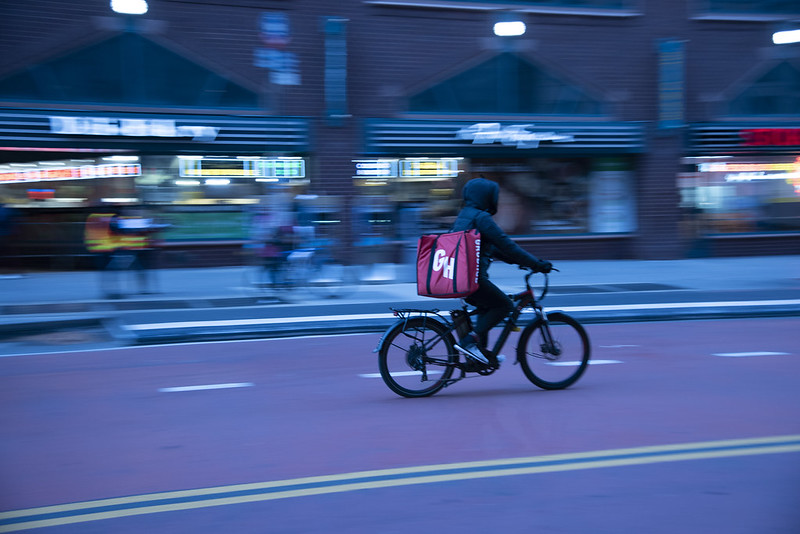 One of the sectors of the U.S. economy that has seemingly thrived through the COVID-19 pandemic—indeed, because of the pandemic—has been food delivery services. Buoyed by successful firms like GrubHub and DoorDash, food delivery apps have benefitted from increased demand due to social distancing and shelter-in-place orders during the pandemic. The top four delivery apps saw a year-over-year increase of $3 billion in combined revenues when comparing the second and third quarters of 2019 and 2020. Global revenues in the food delivery sector have doubled between 2017 and 2020 and are expected to reach $97 billion USD by the year 2024. In its most recent quarterly earnings report, DoorDash announced that it had delivered 345 million orders during 2021’s second quarter, a record for the company, although order growth slowed compared to the first few months of the pandemic.
One of the sectors of the U.S. economy that has seemingly thrived through the COVID-19 pandemic—indeed, because of the pandemic—has been food delivery services. Buoyed by successful firms like GrubHub and DoorDash, food delivery apps have benefitted from increased demand due to social distancing and shelter-in-place orders during the pandemic. The top four delivery apps saw a year-over-year increase of $3 billion in combined revenues when comparing the second and third quarters of 2019 and 2020. Global revenues in the food delivery sector have doubled between 2017 and 2020 and are expected to reach $97 billion USD by the year 2024. In its most recent quarterly earnings report, DoorDash announced that it had delivered 345 million orders during 2021’s second quarter, a record for the company, although order growth slowed compared to the first few months of the pandemic.
Most metropolitan areas across the country, and even some well-populated suburban neighborhoods, are served by drivers who independently contract with several recognizable brands such as the aforementioned GrubHub and DoorDash, as well as UberEats—the top three food delivery services by U.S. monthly sales as of June 2021, according to Bloomberg Second Measure. While each company saw noticeable increases in sales volume during the pandemic, DoorDash secured 56% of U.S. sales during June 2021, ahead of Uber Eat’s 23% market share and GrubHub’s 16% share. While the North American market is a lucrative one for the food delivery sector, there are companies with restaurant delivery operations in several major countries, including Russia, China, Japan, India and throughout Europe, Africa and the Middle East.
Hungry for More
The incredible growth in this sector has encouraged a series of business-expanding activities among the industry’s biggest names. This June, GrubHub shareholders approved a plan for the company to be acquired by European food delivery portal Just Eat Takeaway.com, creating one of the world’s largest food delivery firms by revenue. Then on August 10, enterprise Software-as-a-Service (SaaS) firm Olo announced that it would be supporting GrubHub orders in Olo’s platform that streamlines food delivery orders from multiple platforms for restaurants, and improves restaurants’ ability to publish menus and other important information on those platforms. Uber Eats has already expanded to floral arrangement and consumer retail delivery thanks to partnerships with FTD and Walgreens, according to Uber’s earnings report for the second quarter of 2021.
In recent days, news reports indicate that DoorDash could possibly acquire German-based grocery delivery firm, Gorillas. DoorDash has also rolled out a Double Dash feature that presents anyone placing an order with options to purchase items from nearby convenience and other retail stores. Backlash over fees charged by GrubHub to restaurants for routing telephone calls from the app through GrubHub has spurred the company toward creating a new assisted ordering phone system that will reduce restaurant fees by having GrubHub customer service representatives handle certain inquiries.
Regulators Crack Down
The pandemic-era successes of the food delivery sector have also come with increased scrutiny from legislators and law enforcement officials. In late July, the New York City Council approved a series of bills extending caps to certain charges taken from restaurants by food delivery apps, including a 15% cap on delivery commissions and a 5% cap on marketing fees. The same day those bills were passed, Massachusetts State Attorney General Maura Healey filed a lawsuit in state court against GrubHub alleging that the food delivery firm had been charging fees in excess of state legislation capping delivery commissions at 15%. While the food delivery firms have accepted permanent caps in place during the COVID-19 pandemic, both DoorDash and GrubHub sued the city of San Francisco this July over permanent price controls approved by that city’s council.
Rapid economic growth in any industry sector is bound to create a few IP infringement suits in its wake, and the food delivery sector is no different in this regard. GrubHub’s most recent quarterly earnings report issued this May noted that the company may still face patent infringement claims asserted by Ameranth that were first filed in U.S. district court back in August 2011, although Ameranth has unsuccessfully appealed the district court’s invalidation of its patent claims and its case against GrubHub remains stayed as of September 2018. Similarly, DoorDash’s quarterly earnings report issued this May also notes that the company received a cease-and-desist letter from International Business Machines (IBM) in 2020 telling DoorDash that it infringes on claims of five U.S. patents and inviting licensing negotiations.
The Patents Protecting Your Order
A short survey of patents owned by companies in the food delivery sector shows that research and development at these firms is usually focused upon improving accuracy in deliveries and orders, as well as data collection for improved online ordering, and even competitor analytics.
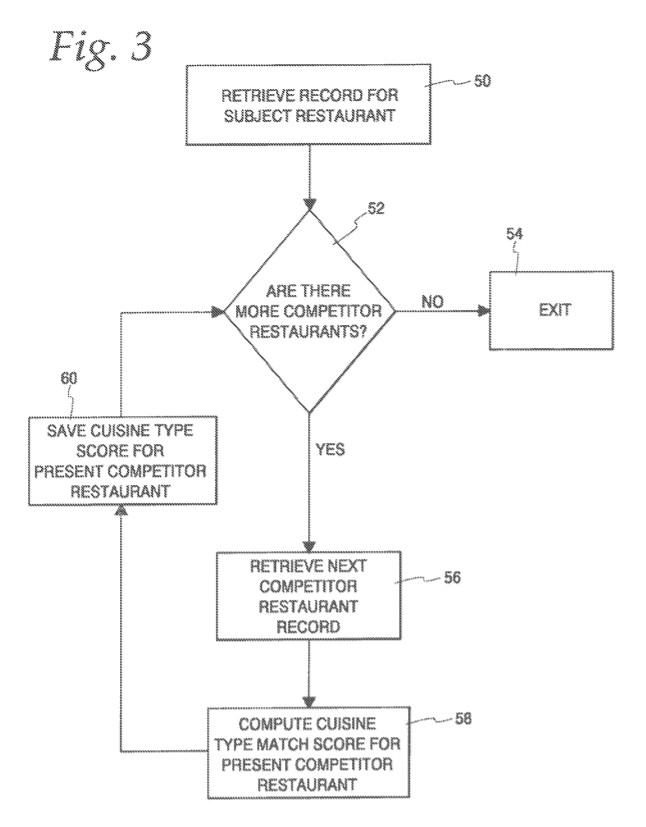 U.S. Patent No. 10565604, System and Method for Determining Competitors of a Restaurant
U.S. Patent No. 10565604, System and Method for Determining Competitors of a Restaurant
In February 2020, the U.S. Patent and Trademark Office (USPTO) issued the ‘604 patent to GrubHub Holdings, which protects a method of determining competitors for a first restaurant within a database of restaurants that involves filtering data for restaurants within a certain distance or offering similar cuisine types, and comparing menu scores and order volumes, to produce a set of competitor restaurants to the first restaurant. The invention is designed to overcome shortcomings in conventional methods of determining restaurant competitors, including market surveys, and address the complexity of comparing competing restaurants that offer different cuisine types but serve similar clienteles.
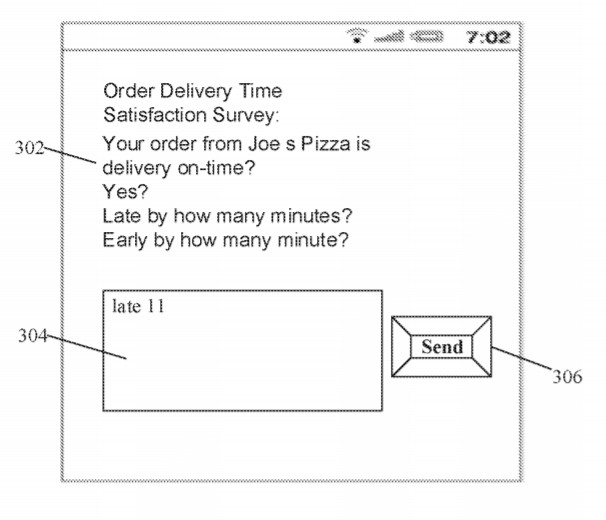 U.S. Patent No. 11080801, , System, Method and Apparatus for Assessing the Accuracy of Estimated Food Delivery Time
U.S. Patent No. 11080801, , System, Method and Apparatus for Assessing the Accuracy of Estimated Food Delivery Time
In the beginning of August, the USPTO issued the ‘801 patent to GrubHub that covers a method performed by a restaurant service system for assessing the accuracy of estimated delivery time provided by a restaurant. The method involves receiving orders from diner devices, sending those orders to a restaurant and determining an order actual delivery time by receiving GPS locations of a set of delivery drivers, selecting times associated with the GPS locations, determining an accuracy measure of an estimated order delivery time, generating a particular delivery time rank for the restaurant based on the accuracy measure, and sending a plurality of restaurant delivery time ranks for display on a diner device. Among the improvements achieved by this invention include providing diners with more accurate information regarding the status of their food orders, including whether the restaurant has confirmed receipt of an order, whether the order is ready for delivery and whether the order is being delivered.
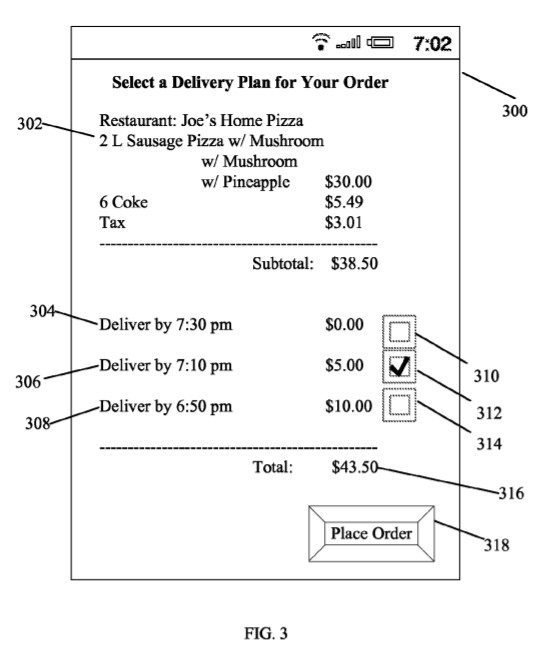 U.S. Patent No. 9710799, System, Method and Apparatus for Receiving Bids From Diners for Expedited Food Delivery
U.S. Patent No. 9710799, System, Method and Apparatus for Receiving Bids From Diners for Expedited Food Delivery
“[D]iners sometimes desire to have their orders delivered earlier than a time dictated by the delivery route and sequence,” notes the specification of the ‘799 patent, issued to GrubHub by the USPTO in July 2017. The patent covers a system for managing incentive-based delivery of made-to-order food including an order server communicating with diner devices and retrieving potential preparation time frames for the order from a restaurant server. These potential time frames are dynamically updated based upon potential delivery time frames obtained from a driver server, and the order server then dynamically formulates a list of incentive based delivery plans for the order based on the potential time frames that are sent to diner devices. This system allows diners to view incentive-based delivery options via a device or Internet browser window, giving them a chance to expedite their order for a higher cost.
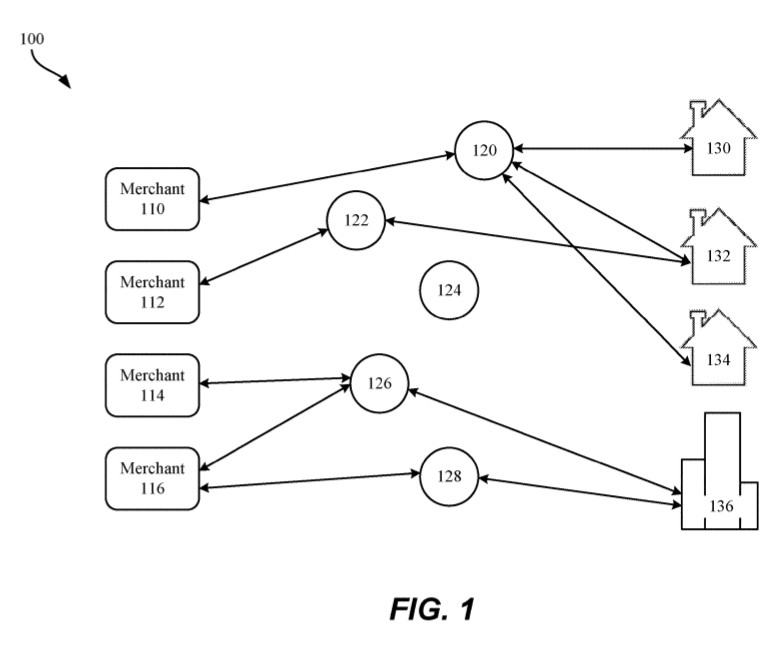 U.S. Patent No. 11037055, System for Dynamic Estimated Time of Arrival Predictive Updates
U.S. Patent No. 11037055, System for Dynamic Estimated Time of Arrival Predictive Updates
This June, the USPTO issued the ‘055 patent to DoorDash protecting a server configured to generate dynamic estimated time of arrival (ETA) predictive updates for real-time delivery of perishable goods. The server comprises an interface receiving confirmation messages corresponding to a series of events for an order, a training dataset including corresponding known time durations between events, and a processor configured to dynamically output ETA predictive updates by weighing factors including events, known time durations and event timestamps. As the ‘055 patent’s specification recognizes, “conventional mechanisms for determining location and status are at best noisy and at worst wrong,” a particular vexing problem for an industry that relies on getting restaurant orders to consumers while those meals are at peak freshness.
 U.S. Patent No. 10657486, Containers for Crowdsourced Delivery
U.S. Patent No. 10657486, Containers for Crowdsourced Delivery
DoorDash’s R&D efforts are focused upon creating a new type of crowdsourced service economy in which “essentially any person with a mobile device is able to almost immediately become a courier,” according to the specification of the ‘486 patent issued by the USPTO to DoorDash in May 2020. It claims a system including a container both for containing a plurality of items during transport to intended recipients and having a communication interface for communicating with a plurality of recipient devices and a plurality of courier devices. The container is designed for placement on a public transport vehicle so that a crowdsourced courier delivers an order to a delivery location, and multiple compartments in the container enables the delivery of multiple orders in a single shipment. The invention improves upon conventional shipping services, such as those provided by the U.S. Postal Service, by incorporating crowdsourced and peer-to-peer delivery techniques.
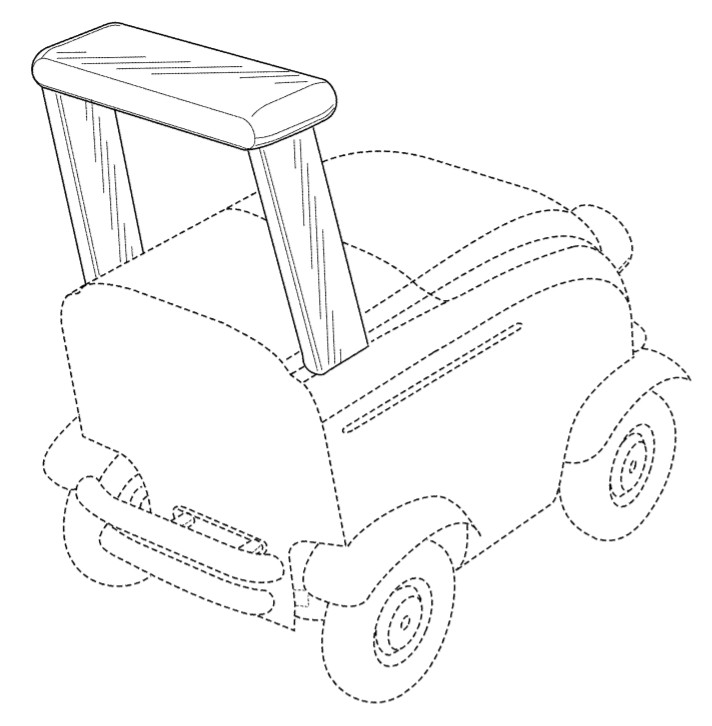 U.S. Patent No. D920870, Sensor Stack for Automated Delivery Vehicle
U.S. Patent No. D920870, Sensor Stack for Automated Delivery Vehicle
At the same time that DoorDash is trying to develop a crowdsourced service economy, it’s also making forays into automated vehicles for delivering orders without human help as is evidenced by the ‘870 design patent issued by the USPTO to DoorDash this June. As with any design patent, only the design of the sensor stack of the automated delivery vehicle is protected and diagrams attached to the patent indicate that the sensor stack resides within a panel held above the vehicle by a pair of arms extending upward from the top of the four-wheeled vehicle.
Image Source: Flickr
Copyright: Julia Justo
Image ID: DSC_2204

![[IPWatchdog Logo]](https://ipwatchdog.com/wp-content/themes/IPWatchdog%20-%202023/assets/images/temp/logo-small@2x.png)

![[Advertisement]](https://ipwatchdog.com/wp-content/uploads/2024/04/UnitedLex-May-2-2024-sidebar-700x500-1.jpg)
![[Advertisement]](https://ipwatchdog.com/wp-content/uploads/2024/04/Artificial-Intelligence-2024-REPLAY-sidebar-700x500-corrected.jpg)
![[Advertisement]](https://ipwatchdog.com/wp-content/uploads/2024/04/Patent-Litigation-Masters-2024-sidebar-700x500-1.jpg)

![[Advertisement]](https://ipwatchdog.com/wp-content/uploads/2021/12/WEBINAR-336-x-280-px.png)
![[Advertisement]](https://ipwatchdog.com/wp-content/uploads/2021/12/2021-Patent-Practice-on-Demand-recorded-Feb-2021-336-x-280.jpg)
![[Advertisement]](https://ipwatchdog.com/wp-content/uploads/2021/12/Ad-4-The-Invent-Patent-System™.png)






Join the Discussion
5 comments so far.
Anon
August 23, 2021 02:10 pmGeorge,
You might be interested in a little actual history of your rosy view of the past (vis a vis “Didn’t used to be that way 100 years ago. Then, it was at least a little more equitable system,). See the sewing machine wars and other then-well-publicized financially draining patent fights.
The notion of “Game of Kings” has been around for far longer than you appear to realize. Now mind you, I am NOT disagreeing with either the view that the US Sovereign system was meant to be different, or that today, the system has been made to suffer (and suffer terribly) given that Big Corp wants a Game of Kings. On those items we find accord.
George
August 20, 2021 09:53 pm@Curious
Unfortunately you’re probably more right than wrong now!
The real problem is that our whole IP system is now just a great big ‘lottery’ where you never know whether you’ve won or lost – until the NEXT legal action! Only in THIS lottery it now costs a ‘literal fortune’ just to enter! Didn’t used to be that way 100 years ago. Then, it was at least a little more equitable system, where even former slaves (having no money) could not only acquire patents, but enforce them too, and thereby become very prosperous (look it up). Now it’s just the sport of kings ONCE AGAIN!
We need to repeal the AIA & start all over again. Our so-called ‘system’ is now just FUBAR!
Pro Say
August 16, 2021 06:00 pmMy thought exactly Curious.
Why, even cavemen (and women!) handed off food from one to another . . . giving instructions where to take it . . . the best path to get there (including how to avoid the dreaded saber-toothed cat) . . . how long it should take . . . being paid (shiny objects an’ such) for doing so . . . etc.
Ooga-booga.
Concerned
August 16, 2021 04:45 pmIt is nice to see the USPTO grant patents when problems are solved even with the use of a computer.
It is sad the USPTO does not grant another patent when the USPTO admits a problem was solved, that the application meets the law as wrote by Congress, that it is proven nobody uses the inventive concept by all end users in the field, and the first examiner wants to grant the patent but states the higher ups are blocking it.
The rejection reasons change like the wind.
Curious
August 16, 2021 01:47 pmAnd all will get flushed down the 101 toilet. If you haven’t invented mid-20th century technology, then it is nothing more than an abstract idea.